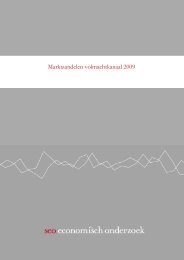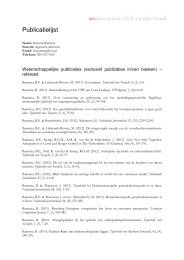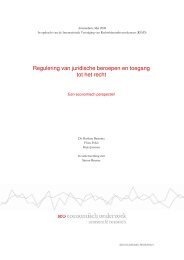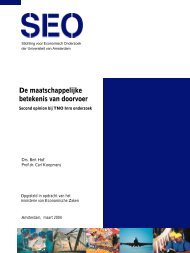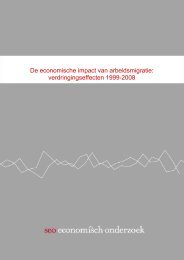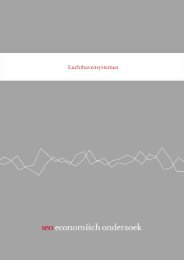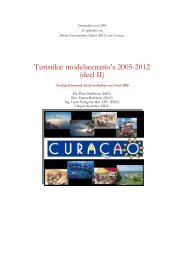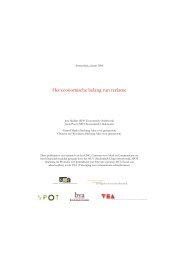Amsterdam, Netherlands - SEO Economisch Onderzoek
Amsterdam, Netherlands - SEO Economisch Onderzoek
Amsterdam, Netherlands - SEO Economisch Onderzoek
Create successful ePaper yourself
Turn your PDF publications into a flip-book with our unique Google optimized e-Paper software.
housing market, on the ‘buying market’ housing prices are upwardly moving – thereby drivingpotential buyers off the market – whereas on the ‘renting market’ students as well aseconomically and socially disadvantaged groups queue up for cheap social housing.Due to the above phenomena the growth of the city population is lagging behind that of suburbanareas. On the medium to long term this implies that employment will shift to the suburban areasas well, since evidence indicates that employment follows population development and not viceversa (Janssen et al., 2006: 20-23). Moreover, suburbanization and urban sprawl are selectivebecause they apply to the relatively well-off, leaving the economically and socially disadvantagedgroups in the cities. A disproportionate share of the economically and socially disadvantaged isconstituted by minority groups with a non-Western origin (non-Western foreign Dutch nationals).Not surprisingly therefore is that <strong>Amsterdam</strong> has a higher than average share of non-Westernforeign Dutch nationals compared to the rest of the <strong>Netherlands</strong> and that this group on averagefaces higher unemployment rates. Hence, whereas in the <strong>Amsterdam</strong> region the share is 25-29 %(depending on the exact region), the Dutch average is around 11 %. In the <strong>Netherlands</strong> as awhole, the share of people aged between 15 and 65 who are receiving social benefits is 14.3% fornative Dutch nationals and 25.2% for non-Western foreign Dutch nationals. In <strong>Amsterdam</strong>,18.1% of native Dutch nationals aged between 15 and 65 are receiving social benefits, whereasfor non-Western foreign Dutch nationals this is 26.2% (Statistics <strong>Netherlands</strong> Statline, 2005c).Good labor market prospects are one side of the story. The other side is how easy it is forbusinesses to recruit the labor they need. The European Cities Monitor 2008 (Cushman &Wakefield, 2008) gives information on business location decisions. In 2008, <strong>Amsterdam</strong> rankedfifth in terms of recruiting qualified staff (of 34 cities in Europe, including Instanbul). So also inthis respect the HEIs seem to be doing well, with again the qualification that the working-ageindividuals available for the labor market may have gotten their education in another region.Also, in the short and medium run the demand for tertiary education may be larger than supply,especially concerning technology, teaching and health care (Jonge and Berger, 2006: 23-24). TheOECD mentions that labor shortages are to be expected because of the aging of society and alsobecause of a weak labor market participation of notably single parents, low-skilled women,partially disabled persons and inactive migrants (OECD, 2008c). None of the proposed solutionsspecifically involves institutes of higher education. The impact of early tracking and ofinflexibility between tracks on the educational attainment of immigrants’ children is said to beadverse (OECD, 2008a: 56, also see Elk et al., 2009).4.3 Localising the learning process4.3.1 Interaction between HEIs and regional needsIn general, in the <strong>Netherlands</strong> private education institutes are more demand-driven than publicinstitutes. UAS are directed more towards the regional labor market than research universities,given that the latter aim for a more generalist preparation and research. At the same time, UAShave a lower intensity of doctoral training among their staff (OECD, 2008a: 33). The downside ofUAS’ local employment connections is a lower national, European and global connection(OECD, 2008a: 64). According to the OECD public authorities in the <strong>Netherlands</strong> have failed tocreate a policy framework in which tertiary education institutions can fully exploit autonomythrough innovation and client-oriented specialization (OECD, 2008a: 34). For example, the socalled‘macro-effectiveness test’ (macro-doelmatigheidstoets) gives institutes less control over(local) programmes. Hence, regional links are limited to begin with. Platform Arbeidsmarkt enOnderwijs (PAO, platform labor market and education) is a public-private partnership that strivesfor well-functioning labor markets in the <strong>Amsterdam</strong> region (PAO, 2009). Especially themunicipality and the business sector seem to be active in the platform. VU University <strong>Amsterdam</strong>for instance is not a partner. PAO’s focus is more on primary and secondary education than onhigher education, because imbalances are more obvious at the lower levels of education.85



